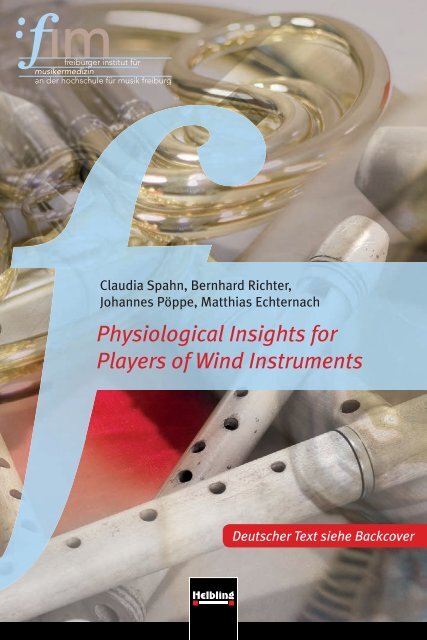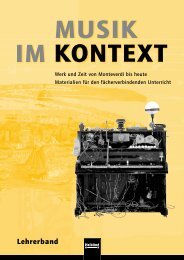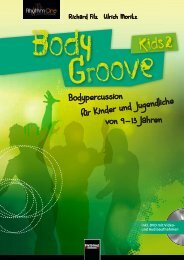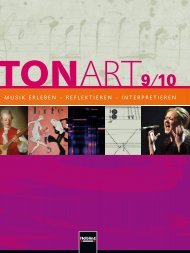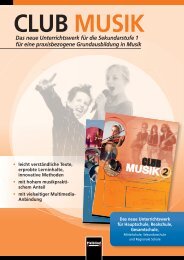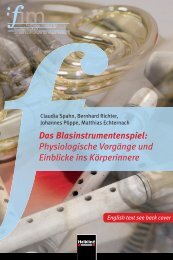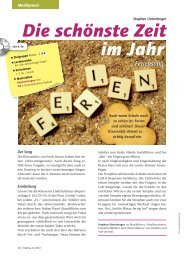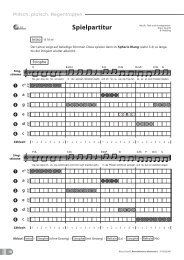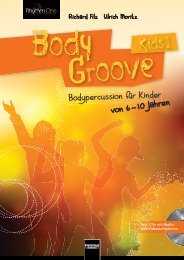Physiological Insights for Players of Wind ... - Helbling Verlag
Physiological Insights for Players of Wind ... - Helbling Verlag
Physiological Insights for Players of Wind ... - Helbling Verlag
Create successful ePaper yourself
Turn your PDF publications into a flip-book with our unique Google optimized e-Paper software.
Claudia Spahn, Bernhard Richter,<br />
Johannes Pöppe, Matthias Echternach<br />
<strong>Physiological</strong> <strong>Insights</strong> <strong>for</strong><br />
<strong>Players</strong> <strong>of</strong> <strong>Wind</strong> Instruments<br />
Deutscher Text siehe Backcover
Contents <strong>of</strong> the DVD-ROM<br />
What actually happens inside the body while someone is playing a<br />
wind instrument<br />
Over the past several years, a group <strong>of</strong> authors from the Freiburg Institute<br />
<strong>of</strong> Musicians’ Medicine (FIM), making use <strong>of</strong> their dual qualifications<br />
as pr<strong>of</strong>essional wind players and singers and Doctors <strong>of</strong> Musicians’<br />
Medicine, have succeeded, with the aid <strong>of</strong> the state-<strong>of</strong>-the art<br />
examination techniques <strong>of</strong>fered by high-tech medicine, in showing<br />
what happens inside the body while someone is playing a wind instrument.<br />
They have produced extensive film material which shows<br />
the movements <strong>of</strong> the lips, tongue, larynx and respiratory system during<br />
tone production and breathing while playing different wind instruments.<br />
This DVD contains 125 short film clips showing the blowing<br />
processes on six different wind instruments. Additional films and animations<br />
explain the most important organs involved in breathing and<br />
blowing and examine the basic physiological processes involved in<br />
wind instrument playing.<br />
How is the DVD organized<br />
The DVD-ROM contains three chapters:<br />
“Basics”<br />
“Instruments”<br />
“Production the Films”<br />
In the chapter Basics, the structure and functioning <strong>of</strong> the organs involved<br />
in tone production is demonstrated and clearly explained by<br />
the use <strong>of</strong> images and videos. The viewer is given in<strong>for</strong>mation about<br />
the lips, the vocal tract, the larynx and the breathing system.<br />
The chapter Instruments contains clips <strong>of</strong> the trumpet, horn, oboe,<br />
clarinet, recorder and flute, filmed using dynamic magnetic resonance<br />
tomography and endoscopy. About 20 clips are shown <strong>for</strong> each instru-<br />
ment, during which important playing techniques<br />
are seen and heard, including tone production (<strong>for</strong><br />
example sustained notes, high and low notes, piano<br />
and <strong>for</strong>te, crescendo and decrescendo), articulation<br />
(single and double<br />
tongue, flutter tongue) and<br />
breathing (sustained notes, dynamics,<br />
vibrato, and circular<br />
breathing). In each case the processes<br />
can be observed in the<br />
vocal tract (tongue), the larynx<br />
and the breathing system (diaphragm).<br />
The chapter Producing the<br />
Films shows how the film clips<br />
<strong>for</strong> the various instruments<br />
were produced and the methods<br />
that were used. To enable<br />
a better understanding <strong>of</strong> the<br />
films in the Instruments chapter,<br />
this chapter explains how<br />
the vocal tract, larynx and<br />
breathing system can be recorded<br />
using dynamic magnetic<br />
resonance tomography, and<br />
how the movement <strong>of</strong> the vocal<br />
folds in the larynx can be made<br />
visible by the use <strong>of</strong> endoscopic<br />
techniques.
What insights does the DVD provide<br />
This DVD-ROM is an innovative medium <strong>for</strong> teaching the playing <strong>of</strong><br />
wind instruments. In designing it, the authors dealt intensively with<br />
the question <strong>of</strong> instrumental pedagogy and multimedia learning and<br />
worked together with soloists, wind instrument educators, pr<strong>of</strong>essors<br />
and music students.<br />
Visual learning, which the film clips on this DVD make possible, opens<br />
up new means <strong>of</strong> accessing the practice <strong>of</strong> wind instrument playing<br />
using modern didactics. Knowledge <strong>of</strong> the correlations between the<br />
processes occurring within the body and the physiology <strong>of</strong> breathing<br />
leads to a deepened understanding <strong>of</strong> one’s own instrumental practice.<br />
“<br />
Two statements represent the wealth <strong>of</strong> knowledge contained<br />
within these films:<br />
“In teaching didactics at the University, it is important <strong>for</strong> me<br />
as a person to know how the whole system functions and to<br />
be able to really see it. For me as an educator, such material<br />
is extremely valuable. I expect every teacher and in fact<br />
every pr<strong>of</strong>essional, too, to know how their body functions.<br />
The more one can look inside the body and see things that<br />
are not visible from the outside – and <strong>for</strong> us wind players,<br />
almost all the processes involved are not visible from the outside<br />
– the more interesting it is. Even at such an early stage <strong>of</strong><br />
their careers, my students at the Music School will certainly<br />
at some point be confronted with such material in the <strong>for</strong>m <strong>of</strong><br />
a seminar. For pr<strong>of</strong>essionals it’s a must.”<br />
(Stefan Ruf, hornist, City <strong>of</strong> Basel Music Academy)<br />
At the same time, however, it is<br />
important to prevent any misunderstandings.<br />
The purpose <strong>of</strong> these<br />
film clips is not to present “correct”<br />
or “incorrect” playing techniques,<br />
but rather to show interested wind<br />
players by means <strong>of</strong> separate individual<br />
examples the movements<br />
involved in playing that are not visible<br />
from the outside. The films on the DVD were recorded exclusively<br />
by pr<strong>of</strong>essional wind players who have mastered their instruments<br />
and play with great expertise. However, since these are all individuals,<br />
each with their own individual characteristics, the details <strong>of</strong> the<br />
physiological processes cannot be taken as universally valid or as applicable<br />
in identical <strong>for</strong>m to everybody else.<br />
Thus, even though the films allow us to recognize basic general principles,<br />
it would not be correct to draw concrete doctrines or hard and<br />
fast convictions from specific detailed processes. Our intention is instead<br />
to show how different physiological processes involved in playing<br />
a wind instrument intertwine.<br />
“When I was able to observe the movement <strong>of</strong> the diaphragm<br />
<strong>for</strong> the first time in the film, I finally understood what “support”<br />
meant and could immediately apply it in my playing. At my next<br />
lesson, my teacher congratulated me on my remarkable progress<br />
in breathing technique.”<br />
(Elisabeth Strake, music student majoring in Trumpet)
How to use the DVD<br />
The DVD-ROM has been designed as an educational medium on didactic<br />
principles. To enable a better understanding <strong>of</strong> the medical techniques<br />
shown in the film clips, these are accompanied by spoken commentaries.<br />
The DVD can be used interactively and without prior knowledge <strong>of</strong><br />
medicine in instrumental music classes, in classes in technical methodology<br />
and in music lessons in secondary schools. It is also equally<br />
suitable <strong>for</strong> use in self-study.<br />
The DVD also <strong>of</strong>fers unprecedented insights<br />
even <strong>for</strong> specialists with medical training in<br />
the areas <strong>of</strong> Music Physiology and Musicians’<br />
Medicine. The films can also be used<br />
as innovative instructional material in Music<br />
Physiology classes at university level.<br />
About the Authors<br />
Pr<strong>of</strong>. Dr. Claudia Spahn (born 1963) studied music (recorder) and<br />
medicine, and with a PhD and Pr<strong>of</strong>essorship in Musicians’ Medicine<br />
and a degree in Music Pedagogy has been head <strong>of</strong> the Freiburg Institute<br />
<strong>of</strong> Musicians’ Medicine (FIM) since 2005, together with Pr<strong>of</strong>. Dr.<br />
Bernhard Richter (born 1962), who is a state-certified singer, and likewise<br />
holds a PhD and Pr<strong>of</strong>essorship in Musicians’ Medicine. Johannes<br />
Pöppe (born 1982) studied music (horn) and medicine. As a musician<br />
he has a “Diplom” and a Master’s degree and has played the horn<br />
with the Duisburg Philharmonic Orchestra, among others. He will<br />
complete his medical studies in 2014 and this project is part <strong>of</strong> his<br />
thesis in medicine. Dr. Matthias Echternach (born 1973) works as a<br />
senior physician at the FIM and qualified <strong>for</strong> a Pr<strong>of</strong>essorship in 2010<br />
with a thesis on voice physiology in which dynamic magnetic resonance<br />
tomography was used as an important examination technique.<br />
In order to obtain maximum benefit from the<br />
films, we recommend viewers to first familiarize<br />
themselves with the contents <strong>of</strong> the Basics<br />
chapter. This chapter provides an understanding<br />
<strong>of</strong> the structure and function <strong>of</strong> the organs<br />
involved in playing a wind instrument, and there<strong>for</strong>e enables viewers to<br />
draw the greatest possible advantage from the instrumental clips.<br />
The same applies to the chapter Producing the Films. Here you will<br />
learn how the films were produced and so be better able to appreciate<br />
their quality and be more prepared to overlook certain technical limitations,<br />
such as, <strong>for</strong> example, the sound quality.<br />
In the Instruments chapter it is advisable to watch the films <strong>of</strong> other<br />
instruments as well, as the similarities and differences can provide<br />
additional insights. Particularly in the area <strong>of</strong> breathing, it is fascinating<br />
to compare the different instrumentalists. Because <strong>of</strong> the differing<br />
anatomy <strong>of</strong> the musicians, some <strong>of</strong> the structures, <strong>for</strong> examples the<br />
vocal folds in the endoscopic videos <strong>of</strong> different instruments, are less<br />
easy to see than others.
Dank<br />
Die Autoren sind einer Reihe von Personen zu Dank verpflichtet, die an der Erstellung<br />
des Materials für die DVD beteiligt waren.<br />
Folgende Bläser haben sich für die Filmaufnahmen zur Verfügung gestellt:<br />
Stefan Albrecht (Lehrer für Fachdidaktik und Methodik am Peter-Cornelius-Konservatorium<br />
Mainz)<br />
Agnes Dorwarth (Pr<strong>of</strong>essorin für Blockflöte an der Hochschule für Musik Freiburg)<br />
Reinhold Friedrich (Pr<strong>of</strong>essor für Trompete an der Hochschule für Musik Karlsruhe)<br />
Christian Hommel (Pr<strong>of</strong>essor für Oboe an der Hochschule für Künste Bremen,<br />
Musikhoschule Luzern)<br />
Anton Hollich (Klarinette SWR Sinfonieorchester Baden-Baden und Freiburg)<br />
Johannes Pöppe (Horn)<br />
Bruno Schneider (Pr<strong>of</strong>essor für Horn an der Hochschule für Musik Freiburg)<br />
Johannes Sondermann (Solo-Trompete SWR Sinfonieorchester Baden-Baden und<br />
Freiburg)<br />
Claudia Spahn (Blockflöte)<br />
Martin Spangenberg (Pr<strong>of</strong>essor für Klarinette an der Hochschule für Musik Weimar)<br />
Stephanie Winker (Solo-Flöte Gewandhausorchester Leipzig)<br />
Tobias Zahlten (Klarinettenklasse Hochschule für Musik Freiburg)<br />
Bruno Schneider hat das Projekt durch seine Fragen angestoßen und maßgeblich<br />
befördert. Darüber hinaus haben Stefan Ruf, Stefan Albrecht, Agnes Dorwarth<br />
und Frederic Belli ihre didaktische Expertise zur Konzeption der DVD beigesteuert.<br />
Die kernspintomographischen Filme konnten in der Abteilung Neuroradiologie,<br />
Universitätsklinikum Freiburg, in kollegialer Zusammenarbeit mit Herrn Pr<strong>of</strong>. Dr.<br />
Martin Schumacher, em. Ärztlicher Direktor der Klinik für Neuroradiologie, und<br />
seinem Mitarbeiter Hansjörg Mast erstellt werden.<br />
Dr. Michael Peschka hat in der Anfangsphase den Prototypen einer MR-gängigen<br />
Klarinette gebaut und Bläser für erste Aufnahmen gewonnen. Herr Dr. Thomas<br />
Olesch hat die MR-gängige Querflöte für die Filmaufnahmen angefertigt.<br />
Die Realisation der DVD in der vorliegenden Form wäre ohne das besondere Engagement<br />
von Kerem Unterberger und Johannes Pöppe beim Filmschnitt nicht<br />
möglich gewesen. Patrick Blank hat den Filmen seine deutsche Stimme verliehen.<br />
Die Verwendung von Filmmaterial zur Kernspintomographie erfolgte mit freundlicher<br />
Genehmigung der Firma Siemens. Tracey Webb-Kolbinger und Michael<br />
Burdumy haben die deutschen Texte ins Englische übertragen.<br />
Impressum und Quellennachweis/Legal Notice and References<br />
Herausgeber/Publisher:<br />
Freiburger Institut für Musikermedizin<br />
an der Hochschule für Musik Freiburg und der Medizinischen Fakultät der Albert-Ludwigs-Universität<br />
Freiburg/ Freiburg Institute <strong>of</strong> Musicians’ Medicine<br />
at the Hochschule für Musik Freiburg and the Faculty <strong>of</strong> Medicine at the Albert-<br />
Ludwigs-Universität Freiburg<br />
Autoren/Authors:<br />
Pr<strong>of</strong>. Dr. Claudia Spahn<br />
Pr<strong>of</strong>. Dr. Bernhard Richter<br />
Johannes Pöppe<br />
PD Dr. Matthias Echternach<br />
Redaktion/Editor:<br />
Alwin Wollinger<br />
Sprecher/Speakers:<br />
Patrick Blank, Daniel Richards<br />
Schnitt/Cutting:<br />
Kerem Unterberger<br />
Sound-Editing:<br />
Teddy Maier<br />
Screen Design:<br />
Werbeagentur punkt KOMMA Strich, Freiburg<br />
Illustration:<br />
Korina Kaisershot<br />
Programmierung/Programming:<br />
Michael Kolesnik<br />
C + P 2013 <strong>Helbling</strong> Innsbruck - Esslingen - Bern-Belp<br />
Quellennachweis/References:<br />
Die Nutzungsrechte der Filme und Bilder in der vorliegenden Bearbeitung liegen<br />
beim Universitätsklinikum Freiburg und beim <strong>Helbling</strong> <strong>Verlag</strong>.<br />
Die Verwendung der CD-Aufnahmen in den Filmen von Horn und Querflöte erfolgt<br />
mit freundlicher Genehmigung von Claves Records und Polydor /The rights to use<br />
the movies and images in the existing <strong>for</strong>m is owned by the University Medical<br />
Center Freiburg and <strong>Helbling</strong> <strong>Verlag</strong>. The CD recordings as part <strong>of</strong> the film clips <strong>of</strong><br />
horn and flute are used by courtesy <strong>of</strong> Claves Records and Polydor.


